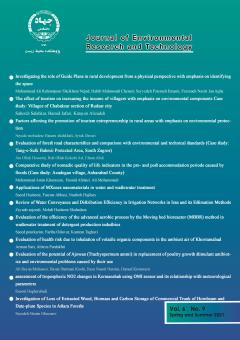Comparative study of nomadic quality of life indicators in the pre- and post accommodation periods caused by floods Case study: Azadegan village, Anbarabad County
Subject Areas : برنامه ریزی؛ آموزش و مدیریت محیط زیست
1 - Tehran University
Keywords: Key words: Quality of life, environmental indicators, nomad’s accomodation, Azadegan village,
Abstract :
Having a good quality of life has always been a human desire. Quality of life in rural areas depends on many factors such as employment, adequate income, access to services such as education and health, health, social security so that factors such as low density of rural settlements, reduced employment and income in the agricultural sector, Inadequate and inefficient communication routes and transportation networks have complicated the implementation of policies necessary to improve the quality of rural life. With this view, the purpose of this study is to study and compare the quality of life indicators before settlement and presence in the nomadic environment and after settlement in Azadegan village after the flood. The research method in this research is descriptive-analytical, based on library-field studies (questionnaire) and searching Internet sites. In order to analyze the data, SPSS software t-test was used. The findings show that the quality of life indicators before and after settlement in Azadegan village with a significant level of less than 0.05% had no positive effects in Azadegan village. Also, the results showed that the components of employment and income in Azadegan village located in Jiroft city did not have a positive effect on job creation for the villagers.
1. بریماني، فرامرز؛ بلوچي، عثمان (1392). ارزیابي کيفيت زندگي در نواحي روستایي با استفاده از سامانه های هوشمند (منطق فازی) (مطالعه موردی: دهستان مهبان شهرستان نيك شهر) ، مجله پژوهش¬های روستایي، دوره 1، شماره 9.
2. پورطاهری، مهدي؛ رکن الدین افتخاری، عبدالرضا؛ حسینی، نعمت الله (1390) نقش میراث فرهنگی در کیفیت زندگی ساکنان روستایی، مطالعه موردی: بخش مرکزی شهرستان لامرد، فصلنامه فضای جغرافیایی، شماره 33، صص 83-100.
3. رضوانی، محمدرضا؛ منصوریان، حسین (1386). سنجش کیفیت زندگی: بررسی مفاهیم، شاخص ها و مدل ها و ارایه مدل پیشنهادی برای نواحی روستایی. فصلنامه روستا و توسعه، سال یازدهم، شماره 3.
4. رضوانی، محمدرضا؛ شکیبا، علیرضا؛ منصوریان، حسین (1387). ارزیابی کیفیت زندگی در نواحی روستایی. فصلنامه رفاه اجتماعی، سال هشتم، شماره 30 .
5. سروش مهر، هما؛ اعظمي، موسي؛ يعقوبي، احمد؛ مهرگان، نادر (1396). ارزيابي کيفيت زندگي روستايي در ايران بر اساس منطق فازي، رفاه اجتماعي، دوره 17، شماره 65.
6. شکویی، حسین (1385). فلسفه های محیطی و مکتب های جغرافیایی، چاپ دوم، انتشارات گیتا شناسی، ص 142.
7. صیدزاده، حیدر؛ رضایی، جعفر (1395). مقایسه وضع درآمدی عشایر اسکان یافته و شناسایی عوامل ایجاد کننده تفاوت¬های درآمدی در دو وضعیت کوچندگی و اسکان در استان ایلام، فصلنامه روستا و توسعه، سال 19، شماره 3.
8. طرح جامع شهرستان جیرفت، سازمان مسکن و شهر سازی، جلد چهارم.
9. طرح هادی روستای آزادگان (1389). سازمان مسکن و شهر سازی جیرفت.
10. فتاحی، أحدالله؛ خراسانی، محمد امین؛ پايدار، ابوذر (1391). کیفیت زندگی و توسعه انسانی، انتشارات انتخاب، تهران.
11. مهدوی، مسعود؛ رضایی، پژمان و قدیری معصوم، مجتبی، (1386)، روستاهای برآمده از اسکان عشایر و چالش¬های آن¬ها، فصلنامه روستا و توسعه، سال 10، شماره 1.
12. مهدوی، مسعود؛ طاهرخوانی، مهدی (1383). کاربرد آمار در جغرافیا، انتشارات قومس، تهران.
13. مرکز آمار ایران (1395). سرشماری عمومی نفوس و مسکن.
14. نجاتی، بهناز؛ حجی پور، محمد؛ میکانیکی، جواد؛ مسینایی نژاد، محمدظاهر؛ ابراهیمی، محمد ابراهیم (1391). اسكان و تحولات اقتصادي – اجتماعي جامعه عشايري (نمونه: كانون آواز در شهرستان درميان)، فصلنامه مطالعات فرهنگي - اجتماعي خراسان، شماره25.
15. Alerstam, T., A. Hedentrom and S. Akesson. (2003). ‘Long-distance migration: evolution and determinants’, Oikos 103: 247–260.
16. Baldwin, Daniel F., Nam P. Suh, and Minoru Shimbo. "Gas dissolution and crystallization in microcellular thermoplastic polyesters." Cellular Polymers 38 (1992): 109-128.
17. Bień, B., & Bień-Barkowska, K. (2016). Objective drivers of sub jective well-being in geriatric inpatients: mobility function and level of education are general predictors of self-evaluated health, feeling of loneliness, and severity of depression symptoms. Quality of Life Re search, 25(12), 3047-3056.
18. Bullock, B. S. and Susie, J. (2004). An Analysis of Technology Use and Quality of Life in a Rural West Texas Community. Austin, University of Texas.
19. Fryxell, J.M. and A.R.E. Sinclair. (1988). ‘Causes and consequences of migration by large herbivores’, Trends in Ecology and Evolution 3, 237–241.
20. Hogan, M. C. et al. (2010). Maternal mortality for 181 countries, 1980–2008: a systematic analysis of progress towards Millennium De velopment Goal 5. The lancet, 375(9726), 1609-1623.
21. Lee, Y.J. (2008). Subjective quality of life measurement in Taipei, Building and Environment, vol 43 (7), pp: 1205–1215.
22. Life Assessment? A Case Study Using the Short from 36 In A Rural Chinese Population'', Springer Science, Busines Media: 31-36.
23. Liu, C; Ningxiu, L; Xiaohui, R; Danping, L, (2009). ''Is Traditional Rural Lifestyle a Barrier for Quality of
24. Niner, Pat, Housing Studies, Vol. 19, No. 2, 141–159, March 2004.
25. Rudi Matthee (2017). Nomad Military Power in Iran and Adjacent Areas in the Islamic Period, Iranian Studies, 50:5, 745-748.
26. Santos, L. and Martins, I. (2007): Monitoring Urban Quality of Life: The Porto experience, Social Indicators Research, 80.
27. Schimmel, J. (2009). Development as happiness: The subjective perception of happiness and UNDP’s analysis of poverty, wealth and development. Journal of Happiness Studies, 10(1), 93-111.

